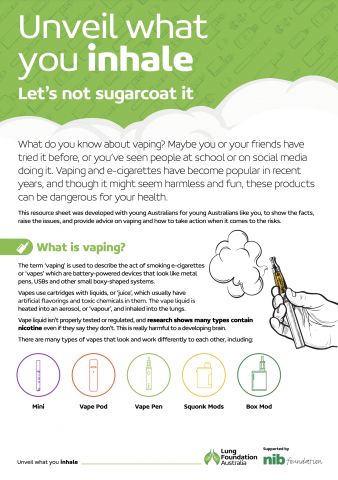E-cigarettes & Vaping
E-cigarettes, otherwise known as vapes, have become increasingly popular. Many people believe that e-cigarettes are ‘less damaging’ for you than traditional cigarette smoking. With a rise in vaping by Australians, particularly among young people, it’s important to understand the long-term health risks.
What is vaping?
Vaping is the act of using an e-cigarette, or ‘vape,’ which are lithium battery-powered devices that use cartridges filled with liquids, or ‘juice.’ The liquids typically contain nicotine, artificial flavourings, and various chemicals, some of which have been shown to be toxic. The liquid is heated into an aerosol, or vapour, and inhaled into the user’s lungs.
Some vapes are designed to look similar to tobacco cigarettes, cigars, and pipes, while others resemble everyday items, such as pens and USBs. Even though e-cigarettes do not contain tobacco many liquids still contain nicotine, which is highly addictive, as well as other chemicals. These chemicals can be toxic when they are inhaled. Some are included to add a fruit, alcohol, or confectionary flavour to the product. In a pioneering study, funded by Lung Foundation Australia, Minderoo Foundation and the Scottish Masonic Charitable Foundation WA, researchers at Curtin University tested the chemicals and toxicity of 52 flavoured e-liquids available for sale over the counter in Australia1. The research unveiled a cocktail of chemicals which raise serious concerns about the safety of these products and their risks to the respiratory health of young people.

Vaping in Australia
It is illegal to use, sell or buy nicotine for use in e-cigarettes to anyone in Australia without a prescription. With the exception of Western Australia, each state and territory permit the sale of vapes and e-cigarettes, but not the sale or purchase of liquid cartridges that contain nicotine. For this reason, many users purchase their products and liquid cartridges online. These products are often imported from overseas, meaning there is little control over how they are manufactured and what they contain.
Smoking cessation
In some cases, doctors can prescribe nicotine e-cigarettes as a means of weaning off tobacco use. There is little evidence that using this method is successful in achieving this outcome. From 1 October 2021, the Australian government will introduce further restrictions to limit access to the use of nicotine e-cigarettes among adolescents and young adults. This will include requiring a valid prescription to import nicotine e-cigarettes and liquids containing nicotine.
Vaping and young people
According to the Australian Institute of Health and Welfare, e-cigarette use by Australians aged 14 or older has more than doubled from 2016 to 2019 and is most common among smokers aged 18–24 at 18.7% (an increase from 6.8% in 2016).
E-cigarettes can serve as a “gateway” to nicotine addiction and tobacco cigarette smoking. There have been many studies which found experimentation with e-cigarettes encouraged the use of tobacco cigarettes, particularly among young people. Research of e-liquids available to purchase over the counter in Australia found 1 in 5 contain nicotine, among a concoction of other toxic chemicals – all had inaccurate labelling. With the inclusion of fruit, alcohol and confectionary flavours, e-cigarettes are designed to appeal to young people. Experts are concerned these products will create another generation of nicotine addiction and a rise in serious health issues including lung disease and cancer.
Lung Foundation Australia has developed a suite of resources to fill the knowledge gap around vaping and e-cigarettes. These resources are designed by and for young Australians, educators and parents and carers, to arm you with accurate and evidence-based information.
 Download the guide to Unveil What you Inhale Guide
Download the guide to Unveil What you Inhale Guide
Health impacts of vaping
Vaping is unsafe and potentially dangerous. While the long-term health effects are unclear, we do know that vaping in the short-term has been associated with nausea, vomiting, mouth and airway irritation, chest pain and heart palpitations. There is a common misconception that vaping is merely harmless water vapour — in fact, it’s an aerosol made up of toxic particles.
These aerosols contain and emit many harmful compounds, including:
- Formaldehyde and acrolein, which can cause irreversible lung damage
- Propylene glycol, which is toxic to human cells
- Nicotine, which is highly addictive and can harm the still-developing adolescent brain, particularly in areas that control attention, learning, mood and behavioural control.
Additionally, vaping is associated with the future uptake of cigarette smoking and can be considered a ‘gateway’ to further risk and health complications.
E-cigarettes and the law
(this info from positivechoices.org.au)
While people over 18-years can legally purchase e-cigarettes and e-cigarette products, it is illegal in Australia to buy or sell nicotine for use in e-cigarettes. However, laws for the use and marketing of e-cigarettes vary across Australia.
See below for State and Territory specific information.
Australian Capital Territory
New South Wales
Northern Territory
Queensland
South Australia
Tasmania
Victoria
Western Australia
Also check the related topics:
Smoking Vaping





